
Max Verstappen is unstoppable: after Imola and Montreal, he wins in Barcelona!
(Cover picture: F1)
Also in Barcelona Max Verstappen applies the law of the strongest, and gets the 61st race win of his career in Formula 1. As happened in Imola and Montreal, the Dutchman was masterful in capitalizing on every slightest mistake of his opponents, today in the form of Lando Norris: the McLaren driver doesn't make the most of his pole position, and has to settle for second place for the fourth time in this 2024 World Championship...
Below is the final classification of the Spanish Grand Prix, on which we can build our analysis of what happened today:
CLASSIFICATION 📋
— Formula 1 (@F1) June 23, 2024
Here's the result from a thrilling afternoon in the Spanish sunshine 🌞🇪🇸#F1 #SpanishGP pic.twitter.com/3iOA4dEYUR
Second race in a row thrown away by the McLaren pitwall, and Max takes advantage of it!
Describing this Spanish Grand Prix as a race won by Max Verstappen or lost by Lando Norris is a difficult task, because it would be wrong to minimize on the one hand the World Champion's merit, who at this stage of the season is making up for the shortcomings of a car that - we can say - has now lost the performance advantage shown in 2023; on the other hand, as seen in Montreal, there is great blame to be attributed to the McLaren strategists, who most likely deprived their top driver of what today would have been a well deserved success.
Steven Tee / Motorsport Images
But let's get to the heart of the race, and understand under what circumstances the victory slipped into the hands of Max Verstappen: to do this, the following graph is very useful, showing the laptimes set by the two over the course of 66 scheduled laps. Before drawing our conclusions, it's worth specifying that the tyre compounds sequence chosen by the two rivals in their race strategy (both on two pitstops) was the same, i.e. Soft - Medium - Soft.
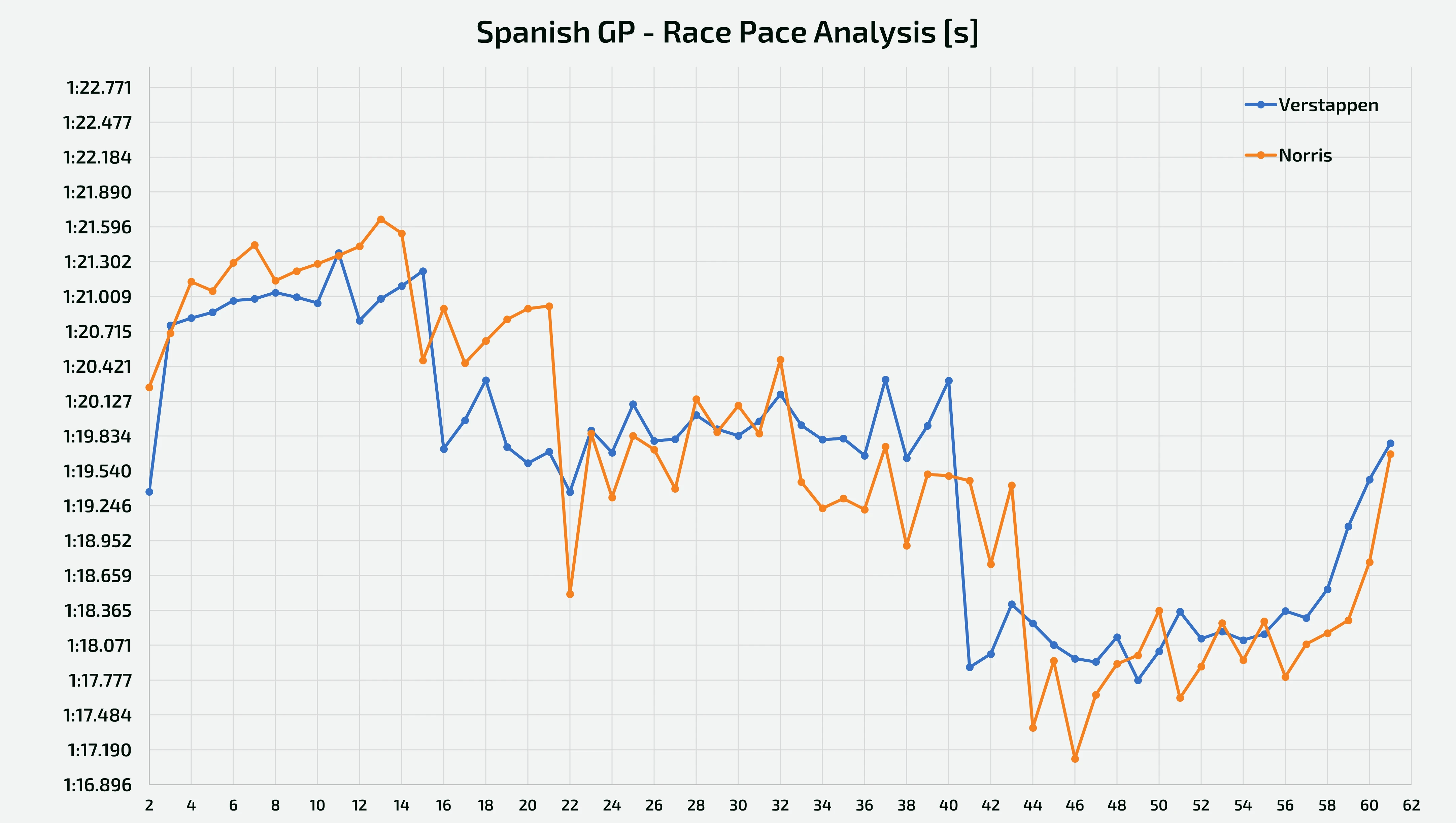
Spanish GP - Analysis of the race pace held by Verstappen and Norris
The first stint is in favour of Verstappen, who on average lapped just under 0.2 s/lap faster than the McLaren Englishman (in the next two stint the situation was going to be reversed): however, the numbers must be combined with the bold albeit careful reading of the race by the champion of Red Bull, who overtook Norris at the start (even putting two wheels on the grass before coming into Turn 1, and who after a couple of laps also got the better of George Russell, who at the getaway surprisingly managed to get past both.
Sam Bloxham / Motorsport Images
Overtaking Russell was achieved with much more difficulty by Norris, who took 16 laps to get rid of the Mercedes driver (when the latter pulled into the pits for his first pitstop). Sixteen laps in which the gap from leader Verstappen rose to 5.1 s, a margin that was not unbridgeable but which protected the Dutchman from a possible undercut: with 50 laps still to go, Lando could have caught Max with relative calm even without "creative" strategies, and instead that's precisely in this situation that the McLaren pitwall put him at a disadvantage...
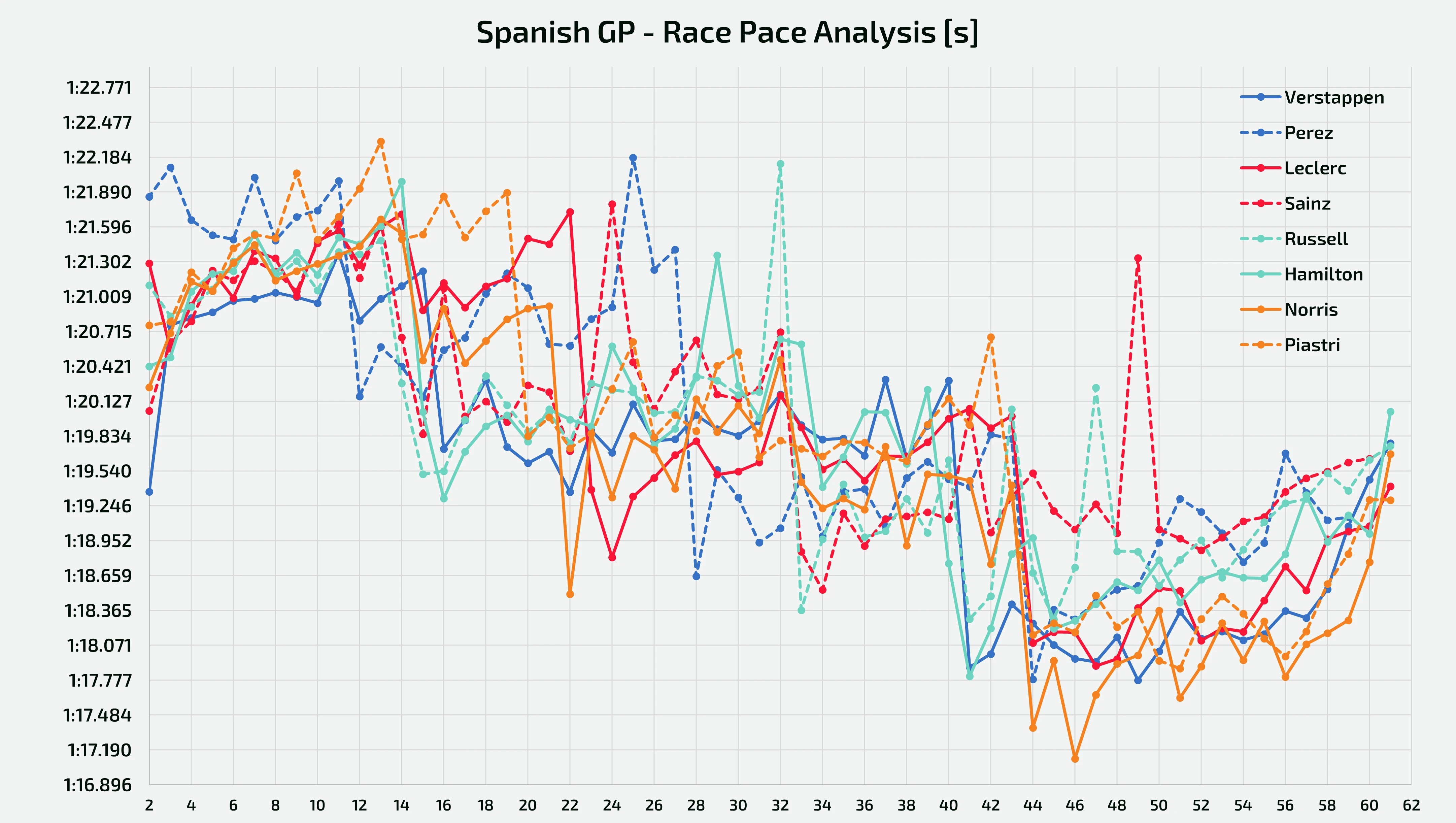
Spanish GP - Race pace held by the first 8 finishers
As can be seen from the graph above, in the laps immediately following the sixteenth all the front runners stopped to change tyres, except Norris and Leclerc, who extended their opening stint until lap 23 and lap 24 respectively: to better understand what has been said in the graph, just look atthe first downward peaks, which represent the fastest lap set by each driver on fresh tyres, in the lap following the outlap.
Coming back on the case of Norris, the postponed pit stop meant that not only the gap from Verstappen went from 5.1 s to 9.0 s, but that Russell, Hamilton and even Sainz slipped between them: in other words, the strategists from the Woking team traded a 6-lap "tyre life delta" for a loss of almost 4.0 s and three track positions, the recovery of which caused Lando to lose further precious time (even if he gave us a spectacular duel to say the least with George, made up of repeated exchanges of position and sequences of corners taken side by side...). A strategy blunder that I honestly don't understand, but which McLaren will have to work on to analyze and avoid similar mistakes being repeated in the coming weekends.
LAP 35/66
— Formula 1 (@F1) June 23, 2024
This is racing at it's absolute finest! 👏
Lando and George go wheel-to-wheel for three corners in a row, but it's the McLaren who gets P2! 🚀#F1 #SpanishGP pic.twitter.com/xi7qtAfvh6
The rest of the laps up to the chequered flag saw Norris getting closer to Verstappen, as a result on the one hand of a McLaren MCL38 which was faster than the Red Bull RB20, and on the other hand of the World Champion's race management, which in the event of his rival rejoining him wanted to make sure he still had something to ask from his tyres and his car in the final laps. Everything went according to his plan, and as mentioned he can celebrate his 61st career victory: among the 7 race wins of this season, the last three fully demonstrate how much Max is an added value for his team, which also serves to deny the rumors that last year attributed all the successes merely to the car!
Eventful race for Mercedes and Ferrari, but they finish in the same starting positions!
The fight for the third step of the podium was a private affair between Mercedes and Ferrari, who after 66 laps, among diversified strategies and frequent position changes, incredibly finished the race in the same positions in which they started!
At the start, as mentioned at the beginning, it was George Russell who put himself in a dominant position, even taking first place in Turn 1... Even if the lead of the race was lost on lap 3, from a podium perspective the best chances were undoubtedly in his hands: so why was he overtaken by his teammate?
Simon Galloway / Motorsport Images
To give the answer to this question, we need to rewind the tape of the race to the first round of pitstops and understand what the pitwall choices of the two teams we're analyzing were... Specifically, both decided to diversify their drivers' strategies as follows:
- Hamilton: Soft (16 laps) - Medium (27 laps) - Soft (23 laps);
- Russell: Soft (15 laps) - Medium (21 laps) - Hard (30 laps);
- Leclerc: Soft (24 laps) - Medium (23 laps) - Soft (19 laps);
- Sainz: Soft (15 laps) - Medium (21 laps) - Hard (30 laps);
In retrospect, it's easy to say that the correct tyre sequence was the one Hamilton and Leclerc opted for, just like Verstappen and Norris up front; however, with tyre degradation still an unknown at that point in the GP, I consider the decision to split the strategies to be correct. The only aspect that coul have been improved was the length of the first stint of Hamilton and Leclerc, too short and too long respectively: whereas the Englishman was forced to lengthen the following stint on Mediums, the Monegasque instead had to run conservatively for the first 24 laps...
Steven Tee / Motorsport Images
In hindsight, considering that the strategy chosen by Ferrari for Leclerc was the most rewarding, it's unlucky that at the end of the first lap there was a duel (and subsequent contact) with teammate Sainz, following which the Spaniard held fifth position ahead of Charles. For his part, Leclerc probably paid for the seconds lost in this circumstance with the inability to attack Russell at the end, when the Englishman was in trouble with his tyres and the Ferrari driver was furiously coming at him. Leclerc expressed his disappointment to the press at the maneuver carried out by Sainz, but the latter sent the accusations back to him...
"The fight wasn't correct, but above all not right at that moment, because we knew that we both had to save the tyres, especially in the last corner: obviously on that particular lap I saved as I had to in the last corner, but I saw Carlos who didn't save at all and overtook me at the end of the straight [...] It's also his home Grand Prix, and I think it's an important moment for his career, but he wanted to do something spectacular in the wrong moment, and it cost us a position: it wasn't a very good moment"
Charles Leclerc
"For me the situation was clear, we had new Soft tyres and Mercedes had used ones, so we had to go on the attack. This is what I did. I don't know what happened to Charles on the first lap, I don't know if he did a mistake, but I had the opportunity to overtake him and it's not like I can stay behind for the rest of my life. Especially because from then on I went on the attack on both Mercedes, and I was close to overtaking them in the first stint"
Carlos Sainz
At a performance level, we can divide the fight between Ferrari and Mercedes "in pairs", exactly with the same criterion with which the strategies were applied to the race: in this way we can contemplate on equal terms, and compare Hamilton's race with that of Leclerc, and that of Russell with Sainz. This last comparison is even more truthful, because - as seen before - the two completed stints of the same length.
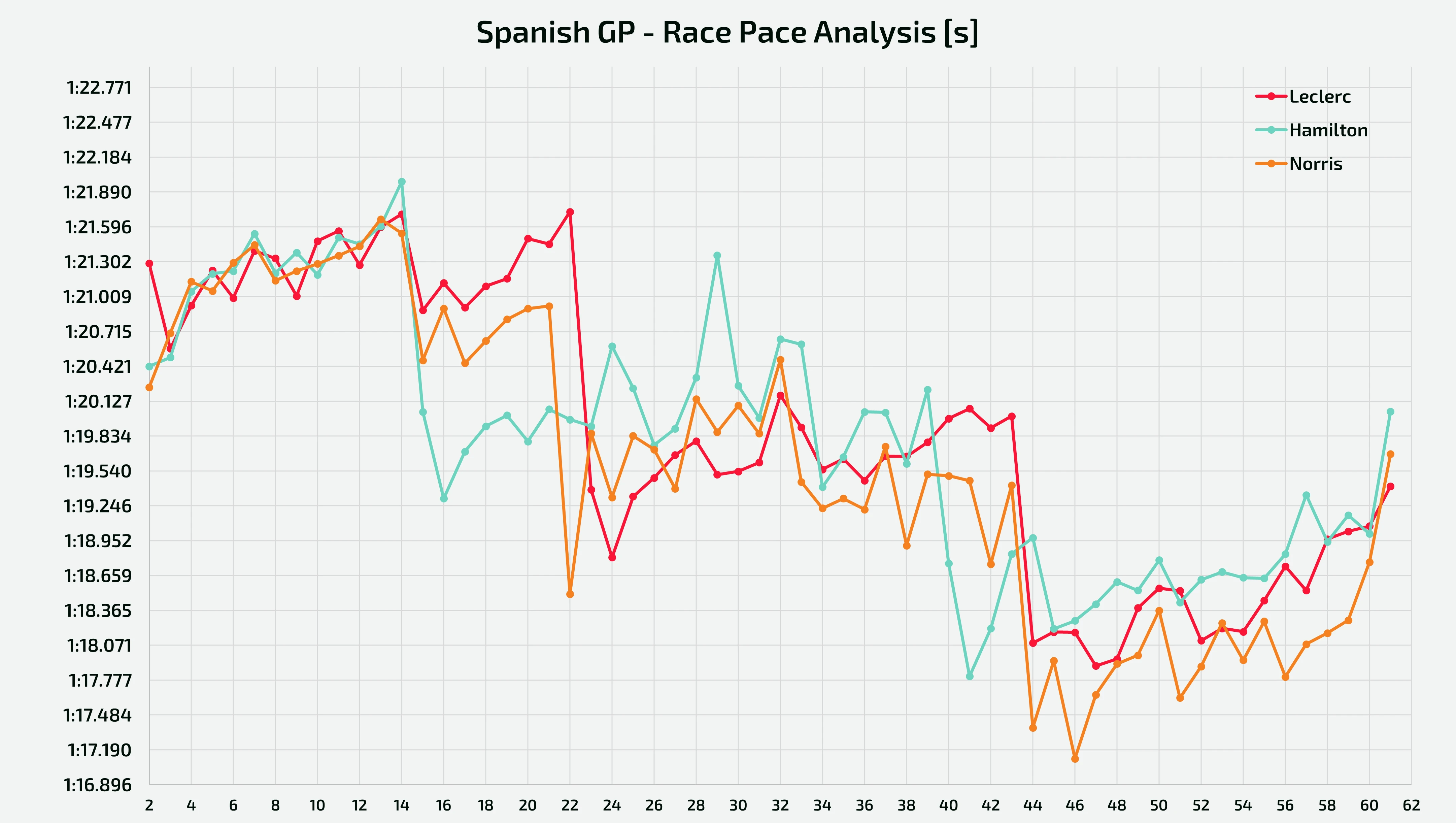
Spanish GP - Race pace held by Norris, Hamilton and Leclerc
In the first of the two comparisons I also added Lando Norris, to give a measure of how much the laptime deficit of Ferrari and Mercedes from McLaren is, as the latter - wrong strategies aside - today confirmed itself as the performance benchmark for everyone.
This comparison sees an almost identical first stint, with the mitigating factor that the race pace in that circumstance was dictated a lot by the traffic of George Russell's Mercedes; when Lewis made his first pitstop, you can clearly see the phase (of 8 laps) in which the Englishman enjoys an advantage of over 1.0 s/lap over the Monegasque at the wheel of his Ferrari; with roles reversed, i.e. with Leclerc "wearing" fresher tyres, the same advantage wasn't replicated... This explains why the second stint ended with a deficit for Hamilton of "only" 0.4 s/lap. At the end of the race, with the Englishman being left without any further goals other than maintaining the third position on the podium taken from Russell, the race pace was still in favour of Charles, this time with a gap of 0.3 s/lap.
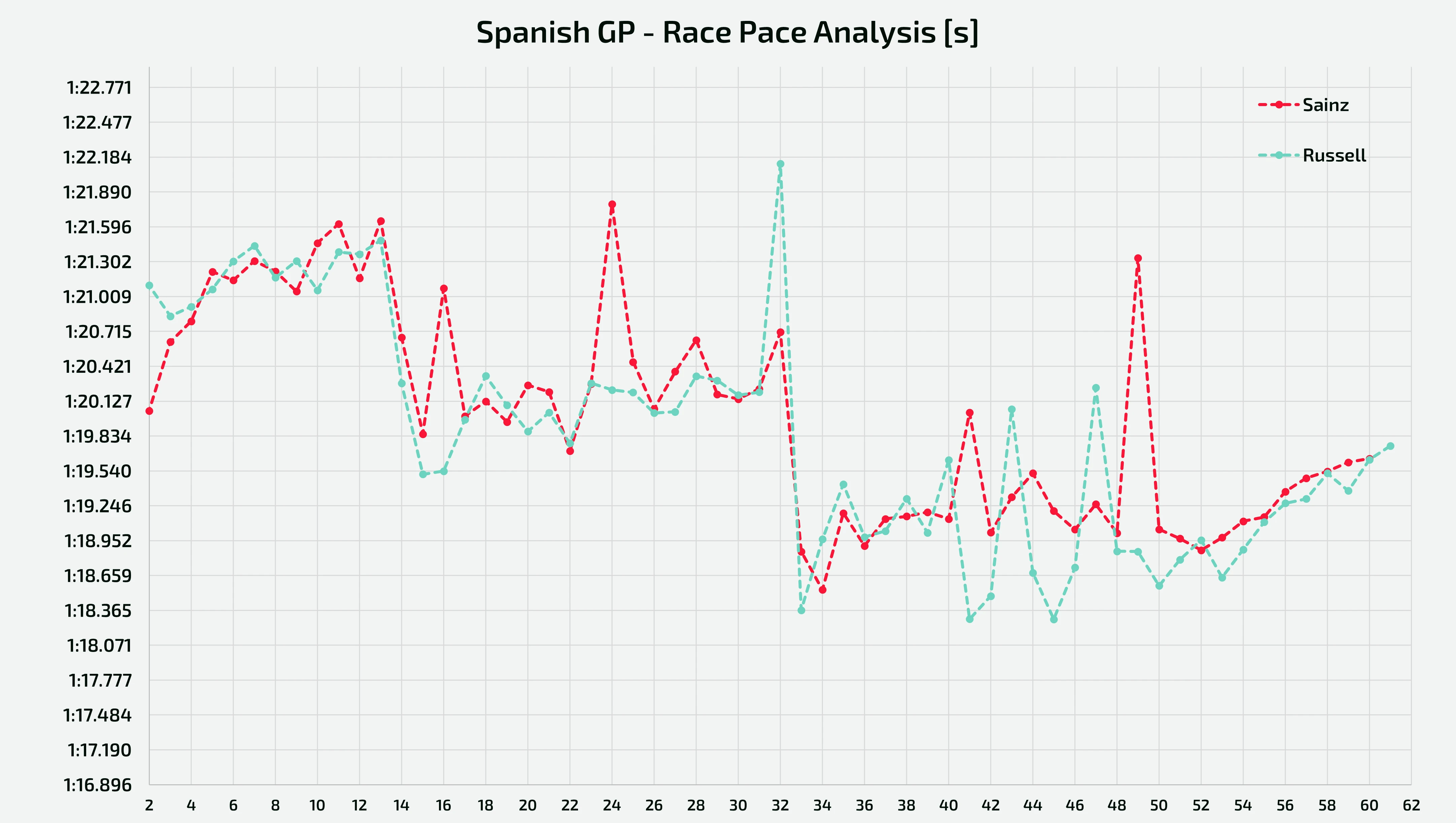
Spanish GP - Race pace held by Russell and Sainz
In comparing the two drivers who finished the race on Hard tyres, the "scan" of the three stints completed allows us to rigorously draw up a progression of the race pace on each of the tyre compounds used over the 66 laps, which provides the "photograph" below:
- Stint 1 (Soft): +0.025 s/lap in favour of Sainz;
- Stint 2 (Medium): +0.178 s/lap in favour of Russell;
- Stint 3 (Hard): +0.202 s/lap in favour of Russell;
For the benefit of a more detailed analysis, below I provide you with a histogram that collects data on the average pace not only of the two drivers just compared, but of all the top 8 finishers (who, numbers in hand, today were on another league compared to the rivals...).
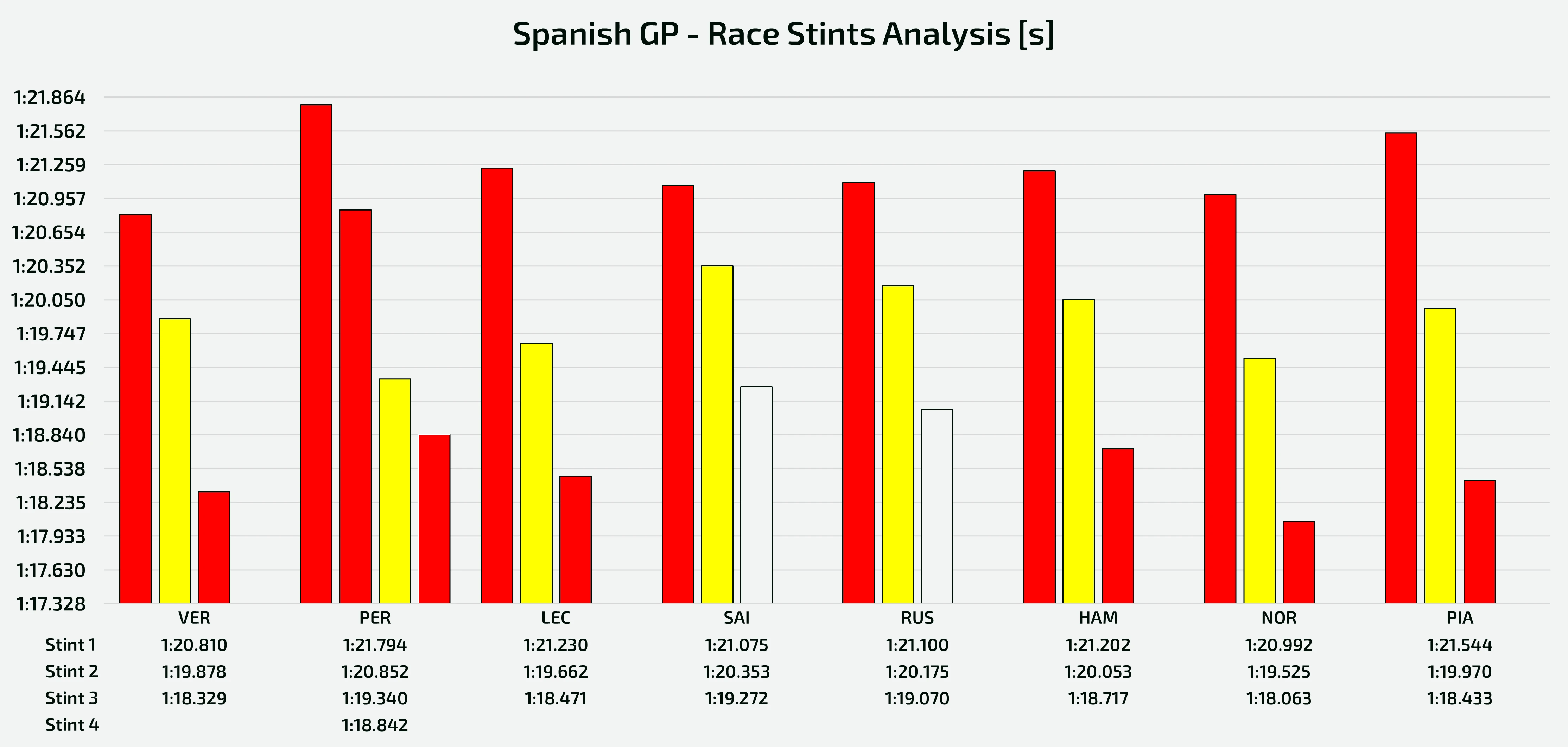
Spanish GP - Analysis of the individual stints of the top 8 finishers
The race in the midfield rewards Alpine, whose drivers are both in the points paying positions
As for the positions in the midfield, the Sunday in Barcelona smiles on Alpine, which as predicted yesterday after qualifying, executes a linear race and takes home 3 points, the result of Pierre Gasly's ninth position at the finish line (at +1'02"025 from Verstappen) and the P10 for Esteban Ocon (at +1'11"889).
Sam Bloxham / Motorsport Images
Just outside the points paying positions we find Nico Hulkenberg, from whom it would have been difficult to ask for more given the racecar at his disposal, and Fernando Alonso, who finishes his 21st career Spanish Grand Prix in an anonymous P12: at Aston Martin being soundly defeated by the same Alpine which at the beginning of the season closed the races at the bottom of the field is not a good sign, but it seems that on the occasion of the British Grand Prix (at Silverstone) a single-seater which is profoundly evolved compared to the AMR24 which is offering little satisfaction to Fernando and Lance Stroll will debut...
Sam Bloxham / Motorsport Images
In conclusion, today's race confirms - unfortunately - the difficulties revealed in qualifying by both Visa CashApp RB and Williams, with the drivers of these two teams competing for little more than the last 4 positions at the finish line. Here too we can read some worrying signs, especially for the team from Faenza, which brought an extensive package of updates right in Barcelona: the hope for them is that in the next weekends of this World Championship the understanding of how these parts work will increase, and with it the performance provided to Ricciardo and Tsunoda!
The World Championship standings in view of the Austrian GP
We close our post-race analysis with a quick look at the World Championship standings, which show few upheavals but, rather, a picture that is gradually taking shape...
Here's how things look in the Driver Standings ⬇️
— Formula 1 (@F1) June 23, 2024
A significant result for Norris, who leapfrogs into P2 behind today's winner, Verstappen 👀#F1 #SpanishGP pic.twitter.com/ecU5yYP2PF
A double points finish helps Alpine leapfrog Haas in the Team Standings 📈
— Formula 1 (@F1) June 23, 2024
Here's the state of play after the Spanish Grand Prix 👇#F1 #SpanishGP pic.twitter.com/ybLvdJScBj
Sure, because whereas Verstappen firmly leads the Drivers' Championship, behind him we can see Norris overtaking Leclerc: for the Ferrari driver the last two races have brought only 10 points, while the better performances and the great consistency of Lando and his McLaren mean that the first pursuer of the World Champion is now the Englishman himself...
Even in the Constructors' Championship the trend is similar, and although Red Bull is still in the lead, Perez's lack of performance (today only eighth at the finish line) means that McLaren (together with Ferrari) could represent a concrete threat for the team from Milton Keynes. In the lower positions, however, the predicted overtaking of Alpine on Haas took place, albeit by just one point... The only team still with zero points is Kick Sauber (or Stake, if you prefer).
Next weekend we'll see the teams immediately back on track for the Austrian Grand Prix in Spielberg, on the Red Bull Ring which this year constitutes the middle event in the triple header of race weekends we are experiencing. So, see you on these pages next Saturday, for our usual post-qualifying article, in the hope that this Formula 1 World Championship will continue to offer us the spectacle that it has become in recent months...
Index
Max Verstappen is unstoppable: after Imola and Montreal, he wins in Barcelona!
- Second race in a row thrown away by the McLaren pitwall, and Max takes advantage of it!
- Eventful race for Mercedes and Ferrari, but they finish in the same starting positions!
- The race in the midfield rewards Alpine, whose drivers are both in the points paying positions
- The World Championship standings in view of the Austrian GP